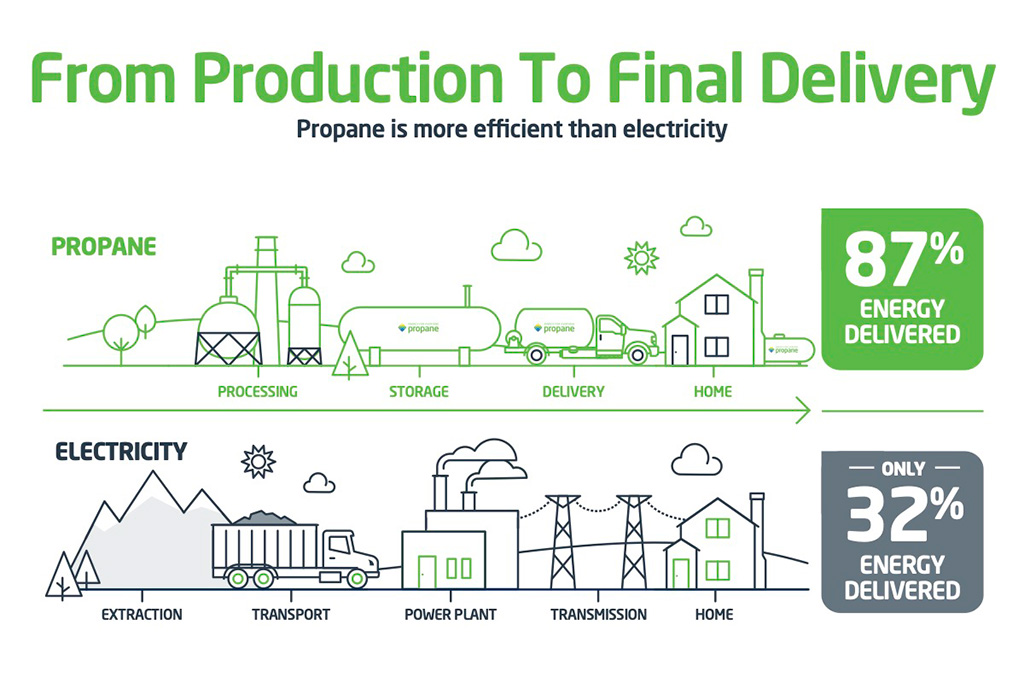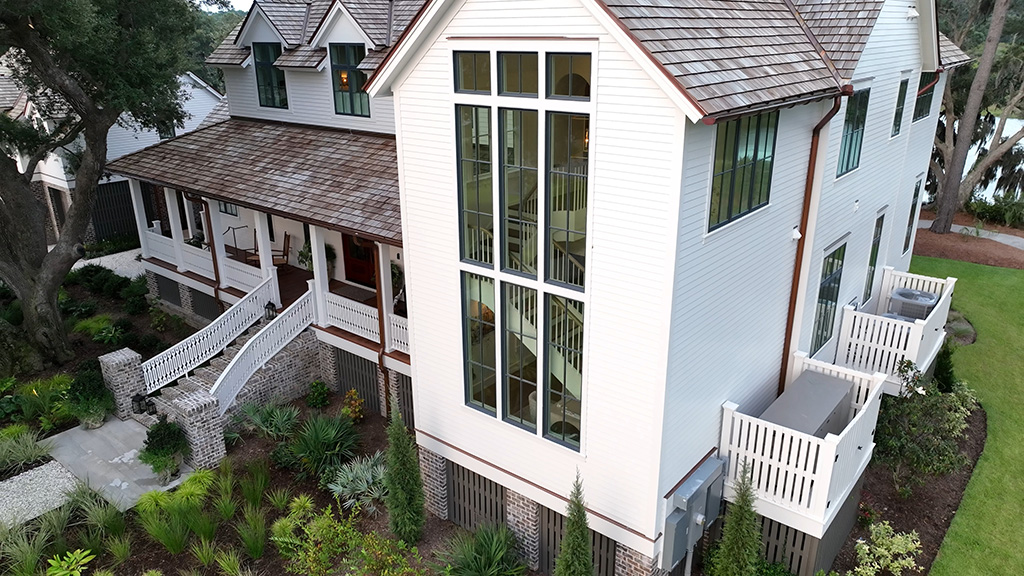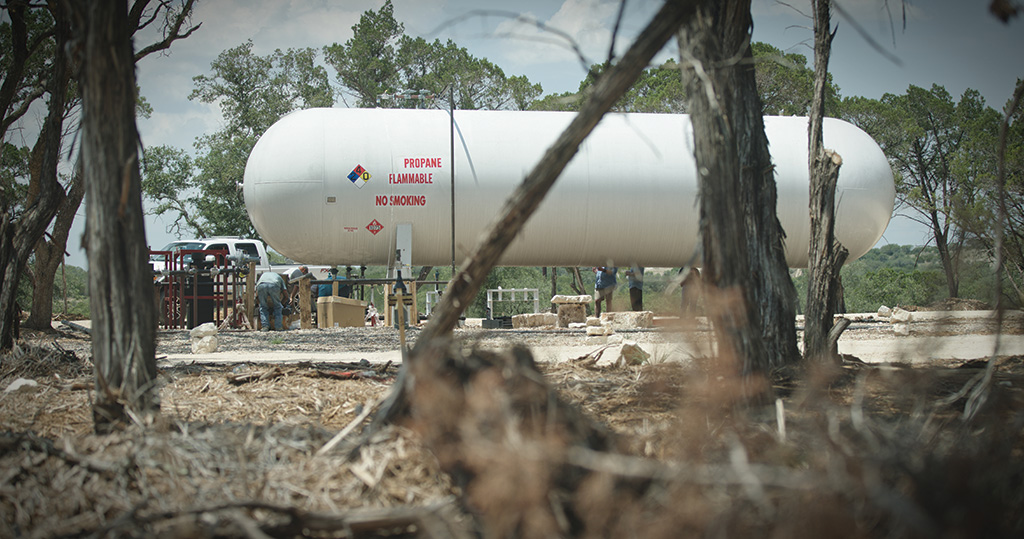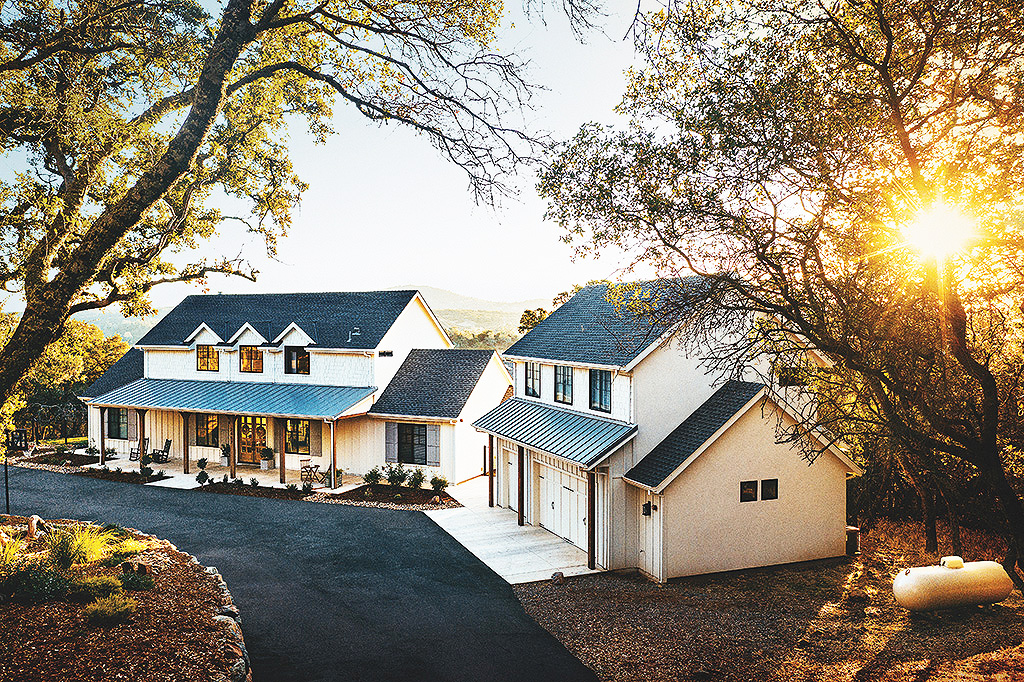
Photo courtesy of Propane Education & Research Council
Morning light reveals a high-performance, modern farmhouse with an on-site propane tank, providing efficient, reliable energy for heating, cooking, and backup power in architect-designed residential systems.
Today’s residential projects demand energy strategies that balance efficiency, sustainability, cost, and resilience. Propane offers architects a flexible, low-carbon fuel that complements electricity, natural gas, heating oil, and solar energy, especially for rural, off-grid, or resilience-focused homes.
What Is Propane?
Propane (C₃H₈) is a hydrocarbon gas widely used in residential construction for space and water heating, cooking, fireplaces, and backup power. Propane is primarily a byproduct of natural gas processing and crude oil refining. During these industrial processes, propane is separated and captured before it would otherwise be wasted, either burned off as flared gas or released into the atmosphere. If not captured, this valuable, energy-dense gas would be lost. By using propane, architects and builders reclaim a source of energy that would otherwise be wasted, using it to power homes, businesses, and job sites.
Why Propane Matters in Residential Architecture
For architects, propane offers flexibility, reliability, and high performance, especially in locations beyond the reach of natural gas pipelines. Stored on site, propane delivers consistent thermal energy for space heating, water heating, cooking, fireplaces, and backup power. Unlike grid-tied electric systems, propane avoids upstream transmission losses and ensures energy availability during outages. With multiple venting and installation options, propane systems integrate easily into diverse building types, supporting resilient design and high-efficiency performance metrics. Its clean combustion also contributes to healthier indoor air and reduced local emissions.
A Domestic and Scalable Energy Source
More than 90 percent of propane used in the U.S. is produced domestically, making it a secure and reliable energy choice. According to the U.S. Energy Information Administration (EIA), the U.S. annually produces nearly 40 billion gallons of propane. Annually, the U.S. uses 10 billion gallons domestically, including residential, commercial, agricultural, transportation, and more, creating the opportunity for a robust export market.
Renewable Propane: Advancing Low-Carbon Building
Renewable propane is chemically identical to conventional propane but is produced from sustainable feedstocks—organic raw materials such as used cooking oil, animal fats, and camelina, a drought-tolerant, non-food oilseed crop. A feedstock is any material used as an input to a production process, and in this context, it refers to waste or renewable biological sources. By capturing and refining these byproducts, renewable propane diverts waste from landfills and reduces the need for extraction. The result is a valuable, low-carbon fuel that supports cleaner energy systems and advances circular economy goals.

Photo courtesy of Propane Education & Research Council
Camelina, a resilient oilseed crop, is a key feedstock in producing renewable propane for low-carbon residential energy systems.
Megajoules (MJ) are a standard energy unit used to evaluate fuels and their environmental impact. One MJ equals one million joules, about the energy needed to boil a quart of water. Carbon intensity (CI), expressed in grams of carbon dioxide equivalent per megajoule (gCO₂e/MJ), measures total greenhouse gas emissions throughout a fuel’s life cycle, including production, refining, transport, and use.
Renewable propane stands out as a low-carbon energy solution, with lifecycle analyses from the California Air Resources Board showing carbon intensity (CI) scores as low as 7 gCO₂e/MJ for camelina-based fuels and around 20 gCO₂e/MJ for waste oil sources, compared to approximately 79 gCO₂e/MJ for conventional propane. Independent data from the Propane Education & Research Council and EnergyStandards.org further validates that renewable propane can reduce emissions by up to 90 percent.
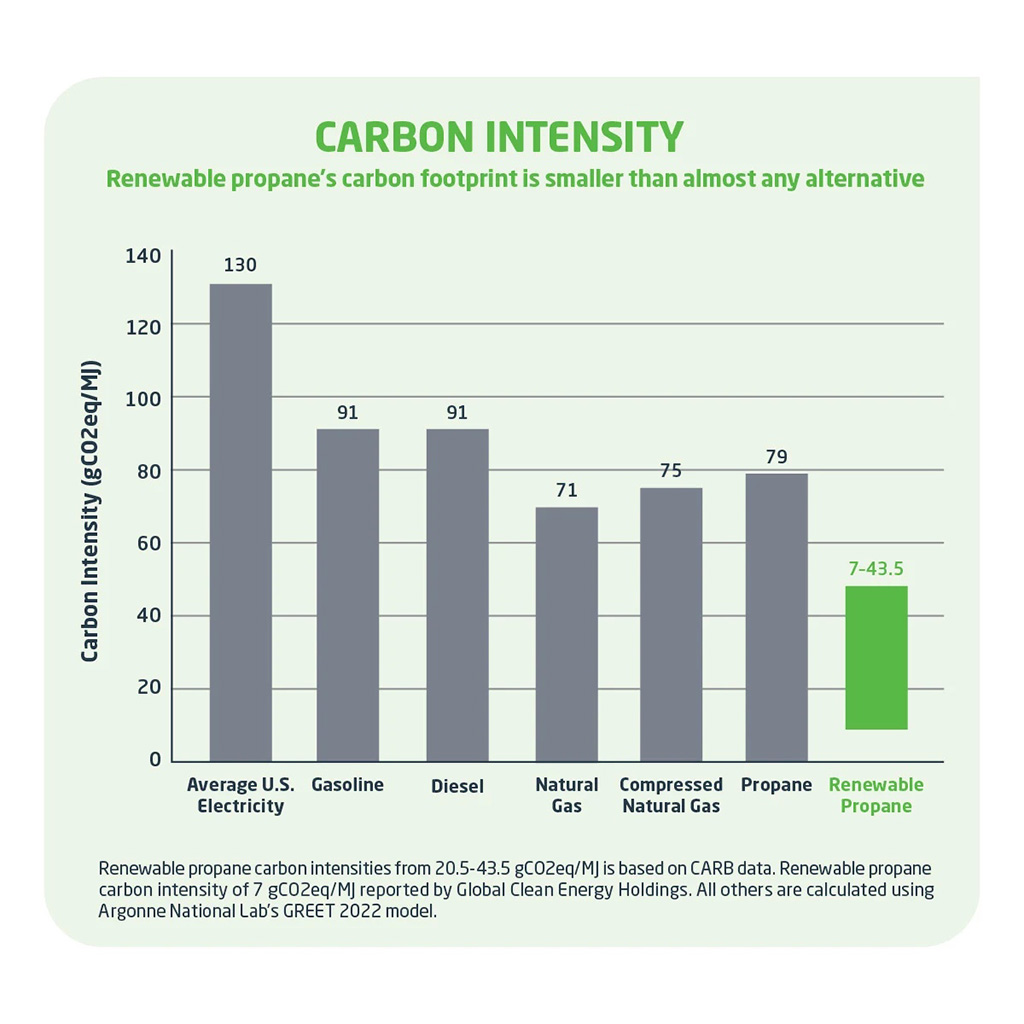
Image courtesy of Propane Education & Research Council
Renewable propane from camelina offers ultra-low carbon intensity, far below electricity, gasoline, diesel, and natural gas.
When viewed alongside other common energy sources, the contrast is even more significant: U.S. electricity averages 130 gCO₂e/MJ, gasoline and diesel each rate at 91, natural gas at 71, and compressed natural gas at 75, according to Argonne National Laboratory’s GREET 2022 model. These figures underscore renewable propane’s value in high-performance, low-emissions residential design.
Renewable propane integrates seamlessly with existing tanks, piping, and appliances, requiring no retrofits. It delivers the same reliable off-grid performance for heating, cooking, and backup power with far lower emissions. Though primarily available only in transportation today, renewable propane is projected to supply up to half the global propane market by 2050, offering architects a practical path to decarbonize homes, especially in rural or off-grid settings, without sacrificing convenience or design flexibility.
Comparing Residential Energy Options
This section examines propane and renewable propane in relation to electricity, natural gas, heating oil, and solar energy, with emphasis on efficiency, infrastructure, and design implications.
Electricity
The dominant residential energy source, electricity generation, remains heavily dependent on fossil fuels. Natural gas and coal account for 60 percent of electricity production in the U.S. Aging grid infrastructure and increasing loads from large facilities like data centers, home appliances, and electric vehicles challenge electricity’s reliability, particularly during extreme weather. Integrating propane with electricity supports resilient, low-emission home designs.
Natural Gas
Natural gas offers cleaner combustion than coal or heating oil, producing about 30 percent less CO₂ than heating oil. However, its reliance on costly and extensive pipeline infrastructure limits availability to more densely populated urban areas. In contrast, propane provides comparable energy performance with far greater flexibility. Because it is stored on-site and transported by truck, propane is ideally suited for rural and off-grid applications, but also for new residential developments where lot sizes are larger and housing density is too low to justify the capital investment required for natural gas infrastructure. This makes propane a practical and scalable energy solution for a wide range of building sites that fall outside the economic reach of utility gas expansion.
Heating Oil
Common in the Northeast, Mid-Atlantic, and Upper Midwest, heating oil provides reliable heat but carries a higher carbon footprint and environmental risks from leaks. Strict storage regulations are necessary to minimize hazards.
Solar Energy
Renewable and capable of reducing fossil fuel dependence, solar output is inherently variable and site-dependent. Solar installations require substantial, well-oriented roof area and can be cost-prohibitive. Pairing solar with propane can assure continuous energy availability.
Propane’s Role in Health, Sustainability, and Reliable
Home Energy
As architects strive to design homes that are healthier, more sustainable, and resilient to power disruptions, understanding propane’s unique advantages is essential. This section highlights propane’s benefits, from carbon impact to safety, reliability, and cost-effectiveness, showing why it remains a smart energy choice for modern residential projects.
Safety First
Safety is paramount in the propane industry, which follows strict codes regulated by the National Fire Protection Association (NFPA), specifically NFPA 58, the authoritative standard for liquefied petroleum gas safety across all 50 states. Propane’s safety record is strong: it only ignites at temperatures above 920°F, is nontoxic, and includes an odorant to detect leaks. It produces minimal emissions and poses no harm to soil or groundwater, making it a safe and responsible energy choice for homes.
Evaluating Propane’s Carbon Impact
When designing sustainable homes, architects must consider full life cycle carbon emissions, not just end-use efficiency. While electrification is often viewed as low-carbon, most U.S. electricity still comes from fossil fuels, with renewables making up less than 20 percent. Transmission losses further reduce its efficiency. Carbon intensity, which measures emissions from production through end use, shows propane frequently has a lower footprint than electricity, especially depending on the regional grid mix. For example, switching from an electric storage water heater to a propane tankless model cuts CO₂ emissions by 480 pounds annually in Connecticut and up to 5,690 pounds in Missouri. Propane and renewable propane thus provide a low-carbon alternative that supports resilient energy use beyond the grid.
Reliable, Resilient Power
Stored on-site, propane is available during utility outages, making it a key element of resilient home design. Propane-powered standby generators can provide automatic backup power, maintaining comfort and safety during disruptions. This reliability is critical as 28 percent of U.S. households experienced power outages lasting six hours or more in 2023 amid aging infrastructure and increasing extreme weather events.
Cost and Efficiency Benefits
According to the U.S. Department of Energy’s 2023 Representative Average Unit Costs of Energy, propane delivered to residential users costs approximately $32.62 per million BTU, whereas electricity costs $47.36 per million BTU. This indicates that propane is about 30 percent less expensive per unit of energy than electricity. Additionally, high-efficiency propane appliances often recoup their initial cost within five years through reduced energy bills and the elimination of standby losses common with electric water heaters.

Photo courtesy of Propane Education & Research Council
Morning light reveals a high-performance, modern farmhouse with an on-site propane tank, providing efficient, reliable energy for heating, cooking, and backup power in architect-designed residential systems.
Today’s residential projects demand energy strategies that balance efficiency, sustainability, cost, and resilience. Propane offers architects a flexible, low-carbon fuel that complements electricity, natural gas, heating oil, and solar energy, especially for rural, off-grid, or resilience-focused homes.
What Is Propane?
Propane (C₃H₈) is a hydrocarbon gas widely used in residential construction for space and water heating, cooking, fireplaces, and backup power. Propane is primarily a byproduct of natural gas processing and crude oil refining. During these industrial processes, propane is separated and captured before it would otherwise be wasted, either burned off as flared gas or released into the atmosphere. If not captured, this valuable, energy-dense gas would be lost. By using propane, architects and builders reclaim a source of energy that would otherwise be wasted, using it to power homes, businesses, and job sites.
Why Propane Matters in Residential Architecture
For architects, propane offers flexibility, reliability, and high performance, especially in locations beyond the reach of natural gas pipelines. Stored on site, propane delivers consistent thermal energy for space heating, water heating, cooking, fireplaces, and backup power. Unlike grid-tied electric systems, propane avoids upstream transmission losses and ensures energy availability during outages. With multiple venting and installation options, propane systems integrate easily into diverse building types, supporting resilient design and high-efficiency performance metrics. Its clean combustion also contributes to healthier indoor air and reduced local emissions.
A Domestic and Scalable Energy Source
More than 90 percent of propane used in the U.S. is produced domestically, making it a secure and reliable energy choice. According to the U.S. Energy Information Administration (EIA), the U.S. annually produces nearly 40 billion gallons of propane. Annually, the U.S. uses 10 billion gallons domestically, including residential, commercial, agricultural, transportation, and more, creating the opportunity for a robust export market.
Renewable Propane: Advancing Low-Carbon Building
Renewable propane is chemically identical to conventional propane but is produced from sustainable feedstocks—organic raw materials such as used cooking oil, animal fats, and camelina, a drought-tolerant, non-food oilseed crop. A feedstock is any material used as an input to a production process, and in this context, it refers to waste or renewable biological sources. By capturing and refining these byproducts, renewable propane diverts waste from landfills and reduces the need for extraction. The result is a valuable, low-carbon fuel that supports cleaner energy systems and advances circular economy goals.

Photo courtesy of Propane Education & Research Council
Camelina, a resilient oilseed crop, is a key feedstock in producing renewable propane for low-carbon residential energy systems.
Megajoules (MJ) are a standard energy unit used to evaluate fuels and their environmental impact. One MJ equals one million joules, about the energy needed to boil a quart of water. Carbon intensity (CI), expressed in grams of carbon dioxide equivalent per megajoule (gCO₂e/MJ), measures total greenhouse gas emissions throughout a fuel’s life cycle, including production, refining, transport, and use.
Renewable propane stands out as a low-carbon energy solution, with lifecycle analyses from the California Air Resources Board showing carbon intensity (CI) scores as low as 7 gCO₂e/MJ for camelina-based fuels and around 20 gCO₂e/MJ for waste oil sources, compared to approximately 79 gCO₂e/MJ for conventional propane. Independent data from the Propane Education & Research Council and EnergyStandards.org further validates that renewable propane can reduce emissions by up to 90 percent.

Image courtesy of Propane Education & Research Council
Renewable propane from camelina offers ultra-low carbon intensity, far below electricity, gasoline, diesel, and natural gas.
When viewed alongside other common energy sources, the contrast is even more significant: U.S. electricity averages 130 gCO₂e/MJ, gasoline and diesel each rate at 91, natural gas at 71, and compressed natural gas at 75, according to Argonne National Laboratory’s GREET 2022 model. These figures underscore renewable propane’s value in high-performance, low-emissions residential design.
Renewable propane integrates seamlessly with existing tanks, piping, and appliances, requiring no retrofits. It delivers the same reliable off-grid performance for heating, cooking, and backup power with far lower emissions. Though primarily available only in transportation today, renewable propane is projected to supply up to half the global propane market by 2050, offering architects a practical path to decarbonize homes, especially in rural or off-grid settings, without sacrificing convenience or design flexibility.
Comparing Residential Energy Options
This section examines propane and renewable propane in relation to electricity, natural gas, heating oil, and solar energy, with emphasis on efficiency, infrastructure, and design implications.
Electricity
The dominant residential energy source, electricity generation, remains heavily dependent on fossil fuels. Natural gas and coal account for 60 percent of electricity production in the U.S. Aging grid infrastructure and increasing loads from large facilities like data centers, home appliances, and electric vehicles challenge electricity’s reliability, particularly during extreme weather. Integrating propane with electricity supports resilient, low-emission home designs.
Natural Gas
Natural gas offers cleaner combustion than coal or heating oil, producing about 30 percent less CO₂ than heating oil. However, its reliance on costly and extensive pipeline infrastructure limits availability to more densely populated urban areas. In contrast, propane provides comparable energy performance with far greater flexibility. Because it is stored on-site and transported by truck, propane is ideally suited for rural and off-grid applications, but also for new residential developments where lot sizes are larger and housing density is too low to justify the capital investment required for natural gas infrastructure. This makes propane a practical and scalable energy solution for a wide range of building sites that fall outside the economic reach of utility gas expansion.
Heating Oil
Common in the Northeast, Mid-Atlantic, and Upper Midwest, heating oil provides reliable heat but carries a higher carbon footprint and environmental risks from leaks. Strict storage regulations are necessary to minimize hazards.
Solar Energy
Renewable and capable of reducing fossil fuel dependence, solar output is inherently variable and site-dependent. Solar installations require substantial, well-oriented roof area and can be cost-prohibitive. Pairing solar with propane can assure continuous energy availability.
Propane’s Role in Health, Sustainability, and Reliable
Home Energy
As architects strive to design homes that are healthier, more sustainable, and resilient to power disruptions, understanding propane’s unique advantages is essential. This section highlights propane’s benefits, from carbon impact to safety, reliability, and cost-effectiveness, showing why it remains a smart energy choice for modern residential projects.
Safety First
Safety is paramount in the propane industry, which follows strict codes regulated by the National Fire Protection Association (NFPA), specifically NFPA 58, the authoritative standard for liquefied petroleum gas safety across all 50 states. Propane’s safety record is strong: it only ignites at temperatures above 920°F, is nontoxic, and includes an odorant to detect leaks. It produces minimal emissions and poses no harm to soil or groundwater, making it a safe and responsible energy choice for homes.
Evaluating Propane’s Carbon Impact
When designing sustainable homes, architects must consider full life cycle carbon emissions, not just end-use efficiency. While electrification is often viewed as low-carbon, most U.S. electricity still comes from fossil fuels, with renewables making up less than 20 percent. Transmission losses further reduce its efficiency. Carbon intensity, which measures emissions from production through end use, shows propane frequently has a lower footprint than electricity, especially depending on the regional grid mix. For example, switching from an electric storage water heater to a propane tankless model cuts CO₂ emissions by 480 pounds annually in Connecticut and up to 5,690 pounds in Missouri. Propane and renewable propane thus provide a low-carbon alternative that supports resilient energy use beyond the grid.
Reliable, Resilient Power
Stored on-site, propane is available during utility outages, making it a key element of resilient home design. Propane-powered standby generators can provide automatic backup power, maintaining comfort and safety during disruptions. This reliability is critical as 28 percent of U.S. households experienced power outages lasting six hours or more in 2023 amid aging infrastructure and increasing extreme weather events.
Cost and Efficiency Benefits
According to the U.S. Department of Energy’s 2023 Representative Average Unit Costs of Energy, propane delivered to residential users costs approximately $32.62 per million BTU, whereas electricity costs $47.36 per million BTU. This indicates that propane is about 30 percent less expensive per unit of energy than electricity. Additionally, high-efficiency propane appliances often recoup their initial cost within five years through reduced energy bills and the elimination of standby losses common with electric water heaters.
Residential Propane Applications
Propane and renewable propane enable premium indoor and outdoor amenities, reliable backup power, and high-performance appliances, enhancing comfort, resilience, and design flexibility at any building site.
Central Heating Systems
Propane furnaces provide higher supply air temperatures—often up to 25°F warmer at the register—compared to electric heat pumps, resulting in greater indoor comfort. These systems also tend to have longer service lives, up to 10 years more than typical electric heat pumps, while operating in shorter, more efficient cycles that help reduce energy costs. Hydronic radiant systems powered by propane boilers offer another effective heating solution. By circulating hot water through floor or perimeter tubing, these systems maintain the warmest temperatures at the occupant level, enhancing comfort in colder climates.
While electric air-source heat pumps are widely used, they face performance challenges in mixed and cold regions. Below about 35°F, they typically rely on electric resistance backup heat, which is highly energy-intensive and increases utility costs. Users often report discomfort with the cool-feeling supply air (often under 98°F) and the occasional burning odor caused by dust burning off coils during emergency heating cycles. Propane and renewable propane systems avoid these issues by delivering warmer, more consistent heat without the performance drop-offs associated with electric resistance systems.
Hybrid Heat Pump Solutions
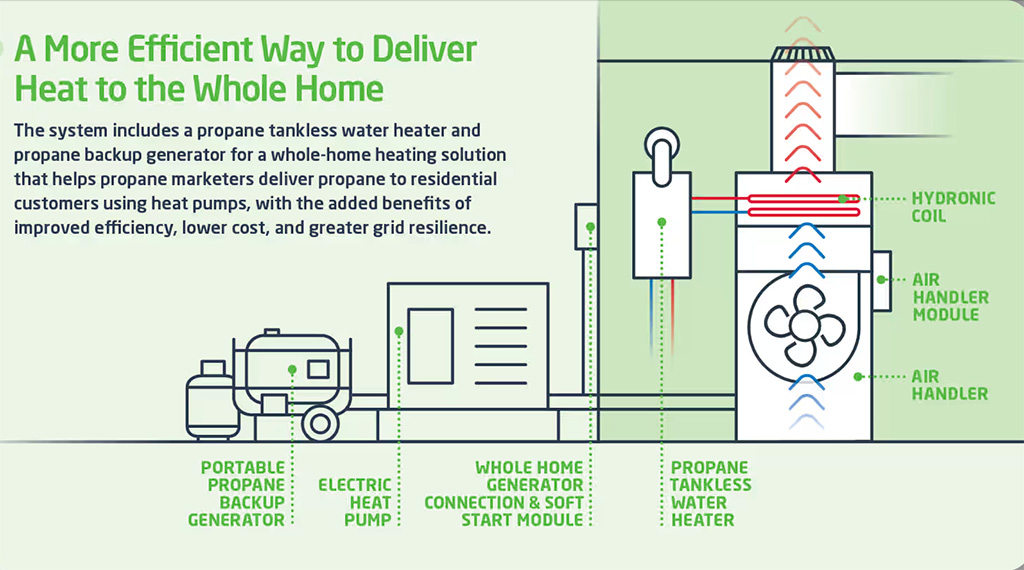
Image courtesy of Propane Education & Research Council
Heat pump solutions pair a propane tankless water heater with a heat pump to boost comfort and cut winter heating costs.
Traditional electric heat pumps struggle to deliver comfort and efficiency in cold temperatures. When the electric heat pump can’t deliver the desired indoor temperature, the unit’s backup system is engaged, which typically relies on resistance heating. This increases the electric demand by three to four times and still fails to provide consistent heat. Recent advances in home heating equipment present an opportunity for propane providers to work with builders and homeowners to enhance the performance of electric heat pumps. Hydronic heat pump solutions like the Heat Pump Helper and the Heat Pump Companion feature hybrid technology to bring the comfort of propane to newly installed or pre-existing heat pumps. Working with an existing thermostat, an air handler module communicates with a propane tankless water heater to circulate hot water through a hydronic coil that has been installed at the air handler. The result is improved efficiency, lower operating costs, and greater comfort for homeowners.

Photo courtesy of Propane Education & Research Council
A technician installs a propane tankless water heater system—an efficient, on-demand solution for residential hot water needs.
The benefits of hybrid heating systems include:
- Comfort—Hybrid heat pump solutions deliver fast and consistent comfort, warming a home without relying on scorched, dry air from electric heat strips.
- Affordability—Compared to all-electric systems, hybrid heat pump solutions reduce operating costs by 35 percent.
- Efficiency—Hybrid heat pump solutions are energy efficient, requiring less amperage while still improving heating performance.
- Flexibility—For homeowners considering future additions of solar- or wind-generated power, a hybrid heat pump solution can make installation more cost-effective due to the reduced electrical peak and running loads.
Absorption Heat Pumps
Mainly used in the past in industrial or commercial settings, absorption heat pumps are an emerging technology for residential applications. According to the Department of Energy, absorption heat pumps are essentially air-source heat pumps driven not by electricity, but by a heat source such as propane, natural gas, solar-heated water, or geothermal-heated water. There are also absorption (or gas-fired) coolers available that work on the same principle. These systems offer a way to achieve the efficiency levels of a heat pump without relying on electricity in areas with high electric rates or unreliable grid power. One air-to-water, gas-fired absorption heat pump, for example, offers heating efficiency at rated conditions of 126 percent, saving up to 40 percent in operational costs compared to condensing boilers, recovering 34 percent of renewable energy from the air.
Water Heaters
Propane storage tank water heaters use a gas burner instead of an electric element, offering the same footprint, utility connections, and venting configurations as natural gas models, making them easily adaptable to existing mechanical layouts. Propane delivers hot water approximately twice as fast as electric systems and can reduce long-term operating costs by up to one-third.
Tankless propane water heaters offer further efficiency by heating water on demand. These systems use high-performance burners and heat exchangers to superheat water in a coil as it flows, eliminating standby losses. Benefits for residential projects include:
- Energy cost reductions of over 50 percent for water heating
- Typical payback periods of three years or less
- Eligibility for state rebates and federal tax credits
- Product lifespans of 20 years or more
From a design standpoint, tankless models reclaim up to 93 percent of the space occupied by traditional tanks, supporting space-saving layouts. Perhaps most compelling for occupants, propane tankless water heaters ensure a continuous, on-demand supply of hot water.
Cooking Appliances

Photo courtesy of Propane Education & Research Council
Propane cooking delivers instant heat and precise control—perfect for everyday meals and family moments in high-performance, chef-inspired kitchens.
According to the American Gas Association, 96 percent of chefs prefer cooking with gas, as propane provides the following benefits: instant gas flames allow cooking without waiting for burners to warm up; propane provides greater control with precise temperature and even heat distribution; propane burners cool quickly after shut-off, while electric cools slowly, which can overcook food and can also be a safety hazard. Homeowners can equip their custom kitchens with gourmet commercial-grade propane ovens and cooktops, convection ovens, griddles, grill tops, and deep fryers.
Clothes Drying
Propane clothes dryers offer homeowners an efficient, convenient, and quick laundry solution. Compared with electric dryers, a propane clothes dryer will dry clothes faster and more efficiently. Propane dryers also offer the latest innovations, such as steam cycles to de-wrinkle and freshen garments, drum lights to better see into the unit, and LCD control screens for ease of use. It’s important to know that gas dryers can be set to run on propane or natural gas, letting the installer know which gas source will be used. New home installations and existing home replacements can both use flexible corrugated stainless-steel tubing (CSST) gas lines. CSST lines are easily routed to the dryer location to expedite the installation.
Propane Fireplaces
In addition to their visual appeal, propane fireplaces offer efficient, flexible supplemental heat with a strong 75 percent return on investment. Unlike traditional wood-burning fireplaces—which lose up to 90 percent of heat through the chimney and operate at only 10 percent efficiency—propane units deliver up to 100 percent efficiency, with minimal heat loss and significantly reduced emissions. They replicate the ambiance of wood fires without the smoke, ash, or indoor air quality concerns. Available in vented, direct vent, vent-free, and power-vented configurations, propane fireplaces are easy to install in new or existing homes, even where conventional chimneys aren’t feasible.
High-Performance Outdoor Living with Propane
Outdoor living spaces have become a cornerstone of modern residential design, with 66 percent of homeowners recognizing that well-designed outdoor areas can add up to 30 percent to a home’s value (Laneventure Home Lifestyle Report). Propane is a key enabler of these spaces, delivering clean, efficient, and reliable energy solutions that enhance comfort, extend usability, and support sustainable design goals.
Outdoor Cooking and Heating Comfort
Propane grills are favored for their rapid heat-up and cool-down times, ease of maintenance, and notably cleaner burn. Compared to charcoal grills, propane emits 105 times less carbon monoxide, according to the EPA, making it a practical and eco-friendly choice for outdoor kitchens and barbecue areas. Beyond cooking, propane fireplaces and patio heaters bring warmth and ambiance to patios, decks, and terraces. Weather-resistant propane fireplaces create inviting focal points, while patio heaters can raise ambient temperatures by 10 to 30°F over a 20-foot radius, extending outdoor living seasons well into cooler months.
Elegant Ambient Lighting

Photo courtesy of Propane Education & Research Council
Propane gas lamps add timeless charm and reliable illumination, enhancing curb appeal and safety, even during power outages or grid disruptions.
Flame-based propane lighting offers a unique combination of elegance and resilience. Operating independently of the electric grid, propane gas lamps provide a flicker-free, warm glow that enhances safety and curb appeal. Fueled by the home’s propane supply, these fixtures remain functional during power outages and are crafted from durable materials such as hand-forged iron, copper, and marine-grade aluminum, complementing a wide range of architectural styles and climates.
Efficient Pool and Spa Heating
Pools and spas represent significant lifestyle and financial investments, and propane-powered heaters offer a high-performance solution to maximize their usability. Propane heaters transfer heat rapidly through combustion chambers, allowing pools and spas to reach comfortable temperatures quickly and reliably. Output ranges from 5,000 Btu/hour for small spas up to 400,000 Btu/hour for large pools, with efficiency ratings of 90 percent AFUE or higher, according to the Propane Education & Research Council. Unlike many electric heaters, propane units maintain consistent performance regardless of outdoor temperature, reducing run times and energy costs. Their on-site fuel storage ensures dependable operation in off-grid or emergency situations, enhancing overall system resilience.
Add a Glance: Key Facts About Propane in Outdoor Living
- Propane grills emit 105 times less carbon monoxide than charcoal grills
- Propane patio heaters can warm a 20-foot radius, raising temperatures by 10 to 30 degrees Fahrenheit
- Flame-based gas lighting operates independently of electricity, which is ideal during outages
- Propane pool and spa heaters offer up to 90 percent AFUE efficiency, outperforming many electric alternatives
- Propane’s on-site storage enables reliable off-grid operation
Propane Combined Heat and Power
Combined Heat and Power (CHP) systems generate electricity and useful heat simultaneously from a single fuel source, in this case, propane. Unlike traditional power generation that wastes heat, CHP captures this waste thermal energy to provide heating for air or water, reaching overall efficiencies of 75 percent or higher. This is much better than typical separate systems, which operate around 50 percent efficiency. Propane CHP systems use an engine-driven generator to produce electricity while recycling heat that would otherwise be lost. Residential CHP units, ranging from one to eight kilowatts (kW), can meet the energy needs of average single-family homes, with larger options for bigger houses or added loads like pools or guest suites. CHP reduces energy costs, cuts carbon emissions, and enhances resilience by providing backup power during outages. For architects designing sustainable, off-grid, or resilient homes, propane CHP offers a compact, efficient, and reliable energy solution.
Propane System Specification: Services, Tank Sizing, and Installation Options

Photo courtesy of Propane Education & Research Council
Workers install an underground propane tank during construction, ensuring clean, reliable, and efficient energy from the first day of occupancy.
This section outlines how to specify propane systems for residential projects, including service requirements, tank sizing, placement options, and integration with architectural site plans.
Propane Retailers
Propane retailers are licensed energy professionals located nationwide who deliver essential propane services and system support wherever residential construction demands it. Beyond basic fuel supply, many retailers provide a comprehensive suite of products and technical services that align with homebuilding and renovation workflows. Key offerings include:
- Refueling and maintaining existing residential propane tanks, ensuring continuous, reliable operation.
- Supplying, installing, and servicing propane-powered appliances such as high-efficiency water heaters, HVAC units, and architectural hearth systems.
- Delivering and setting up both above-ground and underground storage tanks, with sizing options to fit a range of project needs.
- Designing and installing centralized tank systems connected by underground piping networks to deliver metered propane across entire developments or subdivisions.
- Adding or updating gas piping to integrate new propane equipment or expand existing service.
By partnering with propane retailers early in the design or planning process, architects can streamline fuel logistics, increase efficiency, and improve long-term performance outcomes for residential clients.
Propane System Installation
The integration of a residential propane system begins with the early decision to specify propane as an energy source, typically based on site utility access, energy goals, or a desire for off-grid resilience. Once the home’s architectural plans are developed, propane appliances and systems—such as water heating, space heating, and cooking—are selected based on performance, energy efficiency, and design compatibility. Tank sizing and placement are driven by projected energy loads, site-specific zoning requirements, and neighborhood design guidelines. At this stage, the architect or engineer generates documentation, including site plans and mechanical drawings, required for local permitting authorities.
During construction, the system infrastructure is roughed in. In colder climates, propane-powered temporary heaters are often deployed to maintain interior conditions, protect materials, and keep crews productive. Once construction nears completion, the selected propane tank—either above-ground or underground—is installed. Propane is delivered and stored onsite, and final grading or landscape design is executed to preserve the planned aesthetic. System commissioning follows. Lines are purged, pressure and leak tests are conducted, and appliances are test-fired to verify operation. Local authorities conduct inspections as part of the final step to secure occupancy permits. Once the system passes inspection, the home is fully operational, delivering efficient, reliable, and resilient energy performance from day one.
Tank Siting and Sizing

Photo courtesy of Propane Education & Research Council
Technician levels underground propane tank during installation, ensuring correct placement for safety, efficiency, and code compliance.
While architects may have preferences about tank placement, it’s essential to understand the design implications and regulatory constraints that govern installation. Minimum separation distances must be met based on tank size, proximity to structures, and local and state codes. A qualified propane retailer should always be consulted to ensure compliance with NFPA 58: Liquefied Petroleum Gas Code, which outlines placement standards for both above- and underground tanks. Tanks must be sited to allow for safe delivery and service. Bulk delivery trucks typically carry hoses between 75 and 150 feet in length, so placement must accommodate both regular refueling and emergency access. NFPA 58 requires consideration of numerous surrounding conditions, including:
- Nearby structures or property lines
- Ignition sources and mechanical system intakes
- Lower-level home openings
- Combustible materials and flammable liquid storage
- Underground utilities, septic systems, and water lines
- Distances between multiple tanks in a clustered installation
Underground tanks offer aesthetic and space-planning benefits and are available in various sizes based on load:
- 100–250 gallons for outdoor rooms or standby generators
- 500 gallons for a typical four-bedroom all-gas home
- 1,000-plus gallons for larger homes with features like heated pools or spas
Soil temperature, which remains near 50°F year-round, helps stabilize vaporization rates for buried tanks. In colder climates, frost depth must be accounted for in sizing and placement. A reliable delivery schedule, set by the propane provider based on climate, load, and usage, ensures uninterrupted supply. Homes with generators must store enough propane for extended outages, especially in remote or weather-isolated areas. Remote monitoring equipment is available to show fuel levels to homeowners and propane suppliers. In all cases, propane professionals are key partners in determining safe, efficient, code-compliant tank site selection and sizing.
Understanding Propane Vaporization
Vaporization is the phase-change process that converts liquid propane into gas inside storage tanks, enabling it to power residential appliances. This process is driven by heat and influenced by multiple design factors, including tank size, placement, and environmental conditions. A tank’s vaporization capacity depends largely on its wetted surface area, the part of the tank’s interior wall in contact with liquid propane. As the propane level drops, the wetted area shrinks, reducing vaporization rates and potentially affecting appliance performance.
Temperature also plays a key role. Underground tanks benefit from stable soil temperatures around 50°F, supporting consistent vaporization year-round. In contrast, above-ground tanks are more affected by seasonal and regional air temperature fluctuations. Either type can be properly sized for specific installation locations, sizes, and needs. Proper certification and installation are critical. Tanks must be rated for above- or below-ground use, and northern climate installations must consider frost depth to avoid winter performance issues. Architects should advise clients to coordinate with propane retailers on tank size, location, refills, delivery logistics, and billing to ensure uninterrupted service and optimal system efficiency.
Propane Tank Installation Options
In some cases, underground tank installation may be impractical due to site constraints, local regulations, or budget. In these scenarios, propane storage can be accommodated above ground or in a mounded configuration. An above-ground tank is placed on a code-compliant concrete or engineered foundation and typically painted a light, reflective color to minimize thermal gain and stabilize internal pressure. A range of architectural and landscape screening options—including fencing, shrubbery, and masonry enclosures—can help integrate the tank into the site design without visual disruption.
For sites where excavation is limited but visual integration is a priority, mounded tanks offer a middle ground. These tanks are buried at shallow depths and covered with fill soil, creating a raised mound above grade. Mounded installations reduce the tank’s visibility while requiring less excavation than fully buried systems. If a development does not include a centralized propane utility system, individual homeowners can install an underground tank on their property. This solution is increasingly popular because it preserves site aesthetics while supporting propane-powered indoor and outdoor systems. Only a small access dome remains visible above grade, facilitating safe refueling, inspection, and maintenance.
Notably, propane is nontoxic, non-water soluble, and classified as environmentally benign. As a result, buried propane tanks are exempt from the EPA’s underground storage tank (UST) regulations, offering architects and builders design flexibility without triggering additional regulatory oversight (EPA, 40 CFR Part 280).
Final Steps for Propane Setup
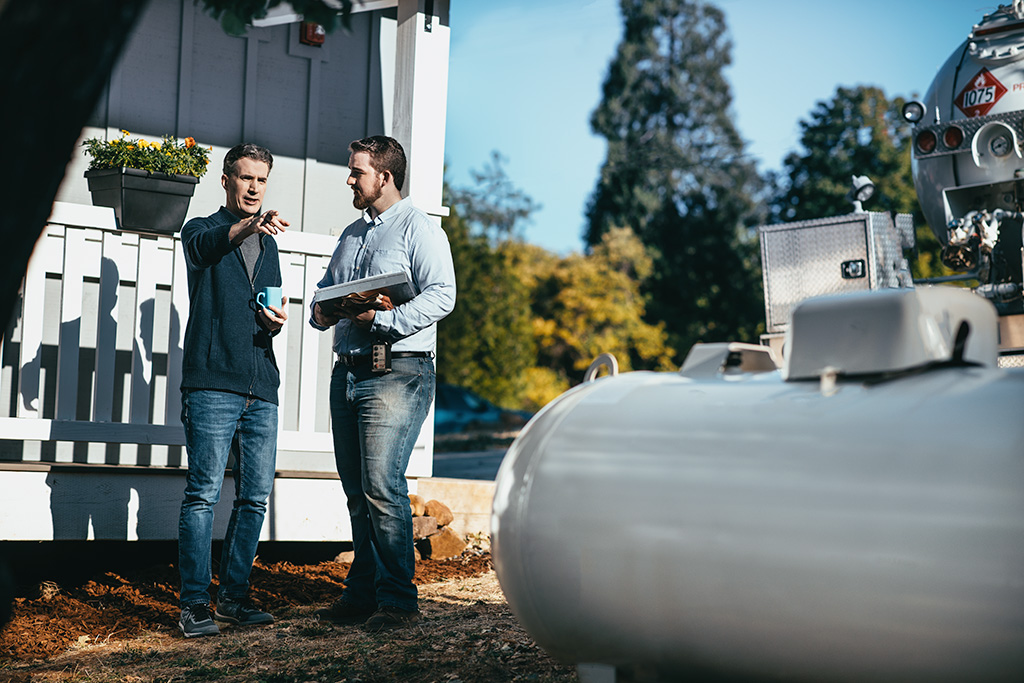
Photo courtesy of Propane Education & Research Council
Propane delivery setup ensures reliable service; homeowners choose to lease or own their tanks for maintenance.
As project closeout approaches, it’s important that the client understands the key steps for establishing reliable propane service. The first action is to contact the selected propane supplier to initiate delivery scheduling and service setup.
Homeowners can either purchase or lease their propane tank. For clients who opt to own the tank, they assume responsibility for its maintenance and safety, tasks that must be performed exclusively by licensed propane service technicians. Alternatively, leasing a tank from the supplier transfers responsibility for maintenance, inspection, and replacement to the propane company, simplifying long-term ownership.
Architects and builders should inform homeowners of these options early to align installation planning with their preferred service model. Proper coordination helps ensure the uninterrupted operation of propane-fueled systems from day one.
Zero Net Energy Homes: A High-Growth Opportunity for Design Professionals
Zero Net Energy (ZNE) and Zero Energy Ready (ZER) homes are among the fastest-growing segments of residential construction, projected to reach a $33 billion market by 2037 (Rocky Mountain Institute). With 83 percent of homebuyers and 89 percent of builders expressing strong interest in ZNE homes, and over 80 percent willing to pay a premium for the associated energy savings and comfort (Propane Education & Research Council), architects and builders who deepen their expertise in ZNE design are well-positioned to lead in this expanding market.
At its core, a ZNE home produces as much energy annually on-site as it consumes, typically through a combination of a highly efficient building envelope and on-site renewable energy generation, most commonly solar photovoltaic (PV) systems. Performance metrics vary, including Site Energy ZNE, Source Energy ZNE, and Zero Energy Ready (ZER), which provide different lenses on energy use and production. For example, Source Energy metrics account for all upstream energy use, offering a more comprehensive view of environmental impact. Achieving ZNE requires a holistic approach where the building envelope, HVAC, lighting, and appliances function as integrated, interdependent systems. Architects must balance rigorous energy efficiency with occupant comfort and practicality.
How Propane Fits into Zero Net Energy Homes
While electricity is often the focus in ZNE homes, propane offers critical complementary benefits that support both energy efficiency and resilience. Propane-fueled appliances—including space heaters, water heaters, cooking appliances, and standby generators—deliver reliable, efficient energy with lower carbon emissions compared to many electric alternatives, especially when paired with renewable propane options. Propane’s high energy density enables rapid heating and precise temperature control, reducing overall energy consumption and increasing occupant comfort. For example, propane water heaters typically heat water faster and with less standby loss than electric models, improving overall system efficiency. Propane space heating provides consistent warmth, even in cold climates where electric heat pumps may lose efficiency.
Backup power is another key area where propane excels. Propane standby generators ensure uninterrupted power during outages, supporting solar PV systems by providing reliable energy when the sun isn’t shining. Unlike diesel generators, propane units are cleaner and quieter, with fuel that can be stored indefinitely without degradation, an important consideration for ZNE homes emphasizing sustainability and resilience. Additionally, propane integrates seamlessly with modern HVAC and mechanical systems designed for ZNE performance. Propane-fueled combined heat and power (CHP) systems can further increase efficiency by capturing waste heat for space or water heating, pushing homes closer to net-zero energy use.
Supporting Codes and Ratings
Most U.S. states have adopted versions of the International Energy Conservation Code (IECC), which includes the Energy Rating Index (ERI) path using the Home Energy Rating System (HERS) Index. Lower HERS scores indicate higher efficiency; ZER homes generally achieve HERS scores in the 40s or 50s, a 40–50 percent improvement over code-built homes. On-site renewable energy, like solar PV, can push scores to zero or below, indicating net positive energy production.
Conclusion
This course highlights propane’s role as more than just a fuel; it is a strategic element in modern residential design. As the construction industry advances toward higher standards of sustainability, resilience, and energy independence, propane emerges as a clean, flexible energy solution that integrates effectively with electricity and renewable systems. Whether applied in grid-connected or off-grid settings, propane enables project teams to meet rigorous performance and emissions goals without sacrificing occupant comfort or architectural intent. From indoor systems to outdoor amenities, propane supports energy-efficient, durable, and aesthetically pleasing design. With thoughtful specification and proper integration, propane helps achieve Zero Net Energy targets and aligns with evolving codes and client expectations. It remains a practical, forward-looking option for professionals committed to designing homes that are both high-performing and future-ready.
Codes, Standards, and Resources Supporting Residential Propane System Design
- NFPA 58 – Liquefied Petroleum Gas Code
The foundational safety standard for propane systems, NFPA 58 governs the storage, handling, and installation of propane tanks and associated equipment. It provides essential requirements for siting tanks, ensuring adequate separation distances, and maintaining compliance with fire safety regulations.
- NFPA 54 / ANSI Z223.1 – National Fuel Gas Code
This standard outlines the proper installation of gas piping, appliances, combustion air, and venting systems. It applies to propane as well as natural gas and is critical for ensuring safe, efficient integration of propane-powered mechanical systems in residential buildings.
- International Residential Code (IRC)
The IRC includes comprehensive provisions for mechanical systems, energy efficiency, and fuel gas installations. It serves as the base code for most U.S. jurisdictions and provides guidance for incorporating propane systems in new home construction and major remodels.
- International Fire Code (IFC)
The IFC addresses fire protection requirements for buildings and developments, including specific provisions for the safe placement of propane tanks. It supports risk reduction through access planning, signage, and proximity regulations.
- OSHA 29 CFR 1910.110 – Storage and Handling of LP-Gases
This federal regulation covers the safe use of liquefied petroleum gases, including propane, particularly in temporary applications like construction heat. It helps ensure jobsite safety during the building process.
- EPA 40 CFR Part 280 – Underground Storage Tank Regulation
Although this regulation governs underground storage tanks (USTs), propane tanks are exempt due to propane’s nontoxic, non-water-soluble nature. This exemption simplifies the permitting and installation process for underground propane systems, offering flexibility for architects and builders.
- Propane Technical Resources from the Propane Education & Research Council (PERC)
PERC provides detailed guidance and planning tools for specifying propane systems in residential projects. Resources include tank siting guides, appliance specifications, CHP system integration, and Zero Net Energy design strategies. These tools help align propane system design with energy efficiency, resilience, and code compliance goals.
- Propane Energy Pod Tool
This modeling tool helps architects and builders evaluate the performance and environmental impact of propane across five key residential energy end uses: space heating, water heating, cooking, clothes drying, and fireplaces. It enables system-level planning aligned with high-performance home goals.
- Combined Heat and Power (CHP) Design Guide
PERC’s CHP guide outlines how to implement propane-powered cogeneration systems that produce both heat and electricity, enhancing energy efficiency and resilience in off-grid or grid-interactive homes.
- Propane Backup Power Planning Resources
Standby generator planning guides provide architects with code-compliant design solutions for integrating propane-fueled backup power into residential projects. These systems support uninterrupted operation during grid outages and complement resilient design strategies.
Resources
National Propane Gas Association. “Economic Impact of the Propane Industry.” 2024. Web. 16 June 2025.
U.S. Energy Information Administration. “Residential Energy Consumption Survey.” 2020. Web. 16 June 2025.
U.S. Energy Information Administration. “U.S. Weekly Clearances of Propane and Propylene Stocks, Production, Imports, Exports, and Product Supplied. Weekly Petroleum Status Report.” Web. 18 June 2025.
Renewable Propane Alliance. “Propane’s Carbon Intensity.” Web. 16 June 2025.
Propane Education & Research Council. “How Much Can You Decarbonize with Tankless?” JLC Online. 2022. Web. 16 June 2025. U.S. Environmental Protection Agency. “Cleaner Propane Backup Generators.” 2021. Web. 15 June 2025.
Propane Education & Research Council. “Propane Combined Heat and Power (CHP) Systems: Efficiency and Applications.” 2023. Web. 15 June 2025.
U.S. Environmental Protection Agency. “Catalog of CHP Technologies.” Web. 15 June 2025.
Propane Education & Research Council. “One tank to fuel them all: Community propane explained.” Web. 2 July 2025.
Propane Education & Research Council. “The New American Remodel Showcase Home at the 2022 International Builders Show.” Web. 16 June 2025.
Florida Solar Energy Center. “Lakeland Zero Energy Home.” Web. 16 June 2025.
Kathy Price-Robinson is a nationally known remodeling and construction writer. Her award-winning remodeling series titled Pardon Our Dust ran for 12 years in the Los Angeles Times. www.kathyprice.com.




